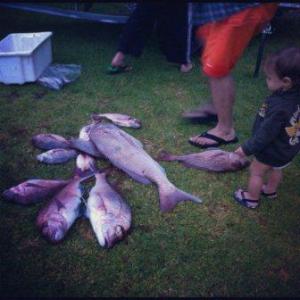My oldest grandson is a mix of a lot of ethnicities–he is, on one half–Maori, Tongan, Hawaiian, Chinese, Samoan with traces of Fijian and on the other half a European mix from Norway to the Netherlands. His name reflects this mixture, influenced by his Maori, Samoan, Scottish and Tongan ancestors. But it is the name that we are called the most that truly becomes who we are and how we think of ourselves. His name is Ngatiwai. His paternal grandmother, who is Maori, suggested that name, it being the name of her tribe, Ngāti Wai, or the “People of the Sea”.
From Te Ara we learn that “Ngāti Wai are descended from Manaia (the captain of the Māhuhu-ki-te-rangi or Ruakaramea canoe) and his people Ngāti Manaia, and are another early Whāngārei tribe.
The history of Ngāti Wai is intimately connected with the coastal waters. The tribe’s name comes from a tradition at Manawahuna, a cave beneath Motu Kōkako, where priests would foretell their fortunes from the way water (wai) passed through the cave. Well known as coastal raiders and traders, Ngāti Wai have links to ancestors from Whangaroa in the north to Tāmaki (Auckland) in the south, and eastward to Little Barrier and Great Barrier islands where Ngāti Rehua, a sub-tribe of Ngāti Wai, settled. Today, most of the tribe live north and south of Whāngārei, and are interspersed with other coastal groups such as Ngāti Kahu, Te Whānauwhero, Te Ākitai and Te Panupuha.”
In December, Ngatiwai’s younger brother, one-year-old Neeson spent two weeks with his paternal grandparents visiting his great-grandparents who still live on coastal tribal lands in Northland, New Zealand. In the distant past Ngāti Wai traded seafood up and down the coast, interspersed with the occasional raid.
December is summer in the Southern Hemisphere with temperatures in Whangaruru ranging from the mid-fifties at night to the upper seventies during the day. While Ngatiwai was bundled up for a Utah winter Neeson spent his two weeks in Whangaruru running around in a t-shirt and eating seafood for breakfast, lunch and dinner. Ngatiwai and his little sister Ngaio have also spent time in Whangaruru before Neeson was born. Memories that will forever keep them tied to their Maori roots.
 There is a special feeling about the land your ancestors lived on–a connection that is hard to define. Rock is rock and sand is sand, right? True, until you stand on land that was there hundreds of years before and someone you share a bloodline with once lived there. Then you close your eyes and you can feel the connection, a sense of security in ancestral lines that transcends geology and testifies to a deeper truth–that this rock and this sand connects you to your people.
There is a special feeling about the land your ancestors lived on–a connection that is hard to define. Rock is rock and sand is sand, right? True, until you stand on land that was there hundreds of years before and someone you share a bloodline with once lived there. Then you close your eyes and you can feel the connection, a sense of security in ancestral lines that transcends geology and testifies to a deeper truth–that this rock and this sand connects you to your people.
Ngatiwai may not yet understand the heritage that he carries or the responsibility that comes with the name he bears to represent his people. First grade is a time for friends and playing. But with grandparents and parents who teach him–someday he will come to feel that same connection with the land and the sea that have been the legacy of the Ngāti Wai for over a thousand years.
Kia ora, Susan Noanoa
Original Publication Date: Jan 30, 2014 at 15:58
Updated: Oct 29, 2025 at 22:58



Recent Comments